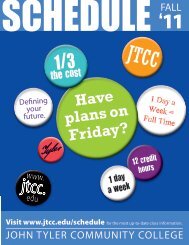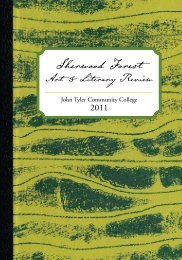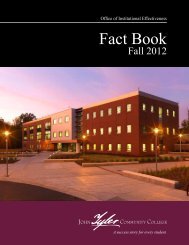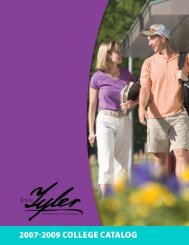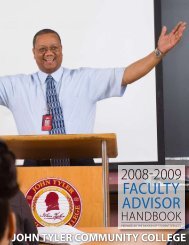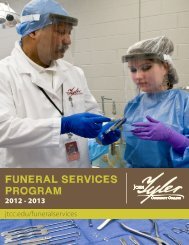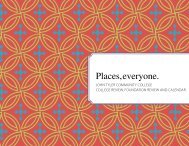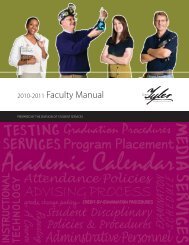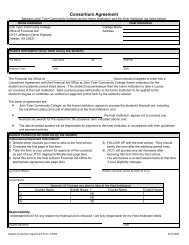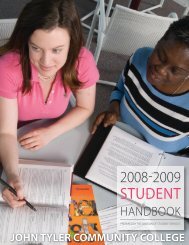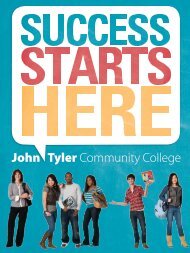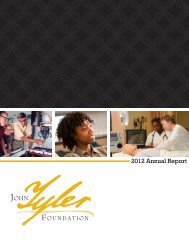defining moments - John Tyler Community College
defining moments - John Tyler Community College
defining moments - John Tyler Community College
You also want an ePaper? Increase the reach of your titles
YUMPU automatically turns print PDFs into web optimized ePapers that Google loves.
<strong>defining</strong> <strong>moments</strong>J o h n T y l e r C o m m u n i t y C o l l e g e1 9 6 7 - 2 0 0 7
Dear Friends,In 2005, <strong>John</strong> <strong>Tyler</strong> <strong>Community</strong> <strong>College</strong> adopted a new <strong>College</strong> slogan,“Defining your Future.” Like most things under the sun, the sloganwas really not so new after all; it was a shortened version of a taglinethe <strong>College</strong> used for many years, “Preserving the Past, Defining the Future.”While the original slogan was a bit long, it does capture what I hope we areable to do every day at <strong>John</strong> <strong>Tyler</strong>. Our past is a proud one – full of peoplewho helped make this college the strong and vital institution it is today.What we have all accomplished together over the last forty years is a pastwe can be proud to preserve.Education is, of course, always about the future. The work we do everyday makes our community’s future brighter, economically richer, and moreculturally diverse. As <strong>John</strong> <strong>Tyler</strong> <strong>Community</strong> <strong>College</strong> celebrates its first40 years, I am pleased to dedicate this publication to everyone who helpedshape the <strong>College</strong>’s exciting present and to those of you who are shapingtomorrow’s bright future.Sincerely,Dr. Marshall W. SmithPresident, <strong>John</strong> <strong>Tyler</strong> <strong>Community</strong> <strong>College</strong>
The interesting thing about trying to capture the history of somethingas complex and extensive as a community college is that memoriesoften blur and collide. There are piles of photos, corners of brightminds, and countless bookshelves of memorabilia to sort through when wetry to discover all that we have accomplished over the last 40 years at <strong>John</strong><strong>Tyler</strong> <strong>Community</strong> <strong>College</strong>. But, there are those <strong>moments</strong> in our rearviewmirror that are in fact, “larger than they seem.” These are the memories of afresh, young faculty and eager students who, in 1967, set the tone for yearsto come. These are the memories of creative risks and strategic challengestaken over the years, which remind us that although our mission is complexand sometimes daunting, what we do is vitally important to our students andto our community. These are the people who have filled the <strong>College</strong> withlife and energy over the last forty years. These are the <strong>moments</strong> that makeus who we are. These are our <strong>defining</strong> <strong>moments</strong>.
60s
During the 1964 session, the General Assembly of Virginia passedlegislation providing for the establishment of two-year technicalcolleges in the Commonwealth. The plan called for a partnershipbetween the Commonwealth and local cities and counties. The new legislationprompted the Appomattox Basin Industrial Development Corporation, a groupof young men in Hopewell who had already established Hopewell <strong>College</strong>,to re-examine their operations. Since the community already had a two-yearcollege in Richard Bland, the group decided the community could best benefitfrom a technical college. Accordingly, they began to work in partnership withother local leaders to study the region’s needs and raise funds for the <strong>College</strong>.Early on, it was decided that the <strong>College</strong> would be named <strong>John</strong> <strong>Tyler</strong> Technical<strong>College</strong> after the tenth president of the United States, who was a native ofthe <strong>College</strong>’s service region. His home, Sherwood Forest (left), is located inCharles City. But, the name <strong>John</strong> <strong>Tyler</strong> Technical <strong>College</strong> would not last long.In a matter of months, legislation would expand the mission of all two-yearcolleges in Virginia, making them community colleges.11
<strong>John</strong> <strong>Tyler</strong> <strong>Community</strong> <strong>College</strong>’s Boardof Directors chose the young Dr. ThomasHatfield (pictured at right in photo) as the<strong>College</strong>’s first president. The 31-year-old fromTexas brought with him a sense of idealism and ayouthful energy that he used to promote <strong>John</strong> <strong>Tyler</strong>to various constituencies in the <strong>College</strong>’s servicearea. “We were young people in a new institution,”says Hatfield. “For many people it was their firsttime teaching at a college, and they wanted to dowell and be thought well of. We all were concernedabout how well we would do. We wanted to get itright. Not only was it a new institution and you’renew to the job yourself, but community collegeswere an innovation. They were utterly new inVirginia. There had never been anything like them- the notion of an open door college that said, ‘Youall come and study anything you want to study. Wehave it for you.’ If you wanted to come and studyfor a vocational skill or technical skill or collegetransfer or art, we can do that for a very low price.”Hatfield and a handful of other early employees ofthe <strong>College</strong>, including Melba Scherer, reported towork each morning at this single-story brick houseon Old Hundred Road in Chester. Hatfield’s officewas in a bedroom. The living room was filled withsecretaries replying to more than 4,000 inquiresfrom prospective students.13
On Wednesday, October 4, 1967Governor Mills E. Godwin dedicated<strong>John</strong> <strong>Tyler</strong> <strong>Community</strong> <strong>College</strong> ata 2:30 p.m. ceremony. Approximately 1,000people were invited to the celebration, whichalso included the unveiling of a portrait ofHarold T. Goyne, who donated the <strong>College</strong>’soriginal 100 acres of land between Interstate 95and Route 301, and a speech by Eugene Sydnor,chair of the State Board of <strong>Community</strong> <strong>College</strong>s(left). <strong>John</strong> <strong>Tyler</strong> was the first communitycollege to be built from the ground up inVirginia, and the dedication ceremony was amomentous occasion well attended by membersof the local community who would now haveaccess to the <strong>College</strong>’s library and manycontinuing education programs. The followingMonday, 1,208 enrolled students would makehistory as the first class to enter <strong>John</strong> <strong>Tyler</strong><strong>Community</strong> <strong>College</strong>.15
Margaret L. Hopkins, who served as the <strong>College</strong>’s first coordinator oflibrary services, came to <strong>John</strong> <strong>Tyler</strong> from Iran. When she first startedat the <strong>College</strong>, Hopkins had little more than a small desk in the houseon Old Hundred Road and boxes of books stacked in the closet. When Hopkinswas finally able to move into the library facility on campus in the weeks before the<strong>College</strong>’s dedication, she still had little more than four bare walls. Hopkins andher assistant David May borrowed extra shelving from the science department untilshelves could be ordered for the library. On the <strong>College</strong>’s opening day, the librarystill had no tables or chairs, but the staff simply explained the situation to studentsand encouraged them to begin to explore the book collection. “I believe a collegelibrary that is only used for décor is expensive,” said Hopkins in a 1967 newspaperarticle. “A community college cannot afford that luxury.”17
The original campus of <strong>John</strong> <strong>Tyler</strong> <strong>Community</strong> <strong>College</strong> was situated inChesterfield County, near Route 10 in Chester. The 100 acres of trees,bushes and flowers surrounding the buildings - lovingly cared for by R.W.Haw, Jr. and others from the building and grounds staff - provided “a lovely parklikesetting” for learning. The campus had three buildings then: Bird, Goyne andGodwin halls. The facilities at the time featured a student lounge, a bookstore,and a greenhouse. Behind Goyne Hall, bright plastic chairs lined the walkways,and students often gathered around the nearby fountain and moat that meanderedthrough campus. Pranksters were known to release fish in the moat, which waseventually overtaken with algae and had to be filled in. Even in the late 1960s,space was tight at the <strong>College</strong>. Faculty offices were in large open areas oftenreferred to as “bullpens” by faculty members, and students were already makingknown their desire for a larger library, a gymnasium and more parking spaces.19
Because students had many differentoptions for their futures, the <strong>College</strong>employed counselors to help guidestudents with class selection, future goals and thechallenges of college life. Carole Royall came tothe <strong>College</strong> as a young member of the counselingdepartment, and she would remain at the <strong>College</strong>for more than 30 years. She was well-known forher involvement in college life and her skill incounseling.23
Because full-time students who enrolled in 12 or morecredit hours paid a flat rate of $45 per quarter, manystudents enrolled in a full schedule of classes andstayed on campus the majority of the day. There were fewchoices for lunch or entertainment beyond the campus, so the<strong>College</strong> provided students with a small cafeteria and a studentlounge filled with ping pong and pool tables, as well as space toeat and study. The lounge was an active scene in those days. Itwas often filled with students, faculty and staff during the day,and in the evenings, the <strong>College</strong> used the space to host dances,concerts and receptions.Being on campus all day also meant that students had plenty oftime for extracurricular activities, including intramural sports,The <strong>Tyler</strong>ation student newspaper, and the folk music club. Astudent government association was also formed. The SGAtook an active interest in events on campus – parking wasalways a hot-button issue – as well as local politics, the <strong>College</strong>administration, and faculty appointments. At the time, studentswith various political interests marched in the hallways,and faculty members, most notably Bob Ward, an assistantprofessor of history, often publicly voiced their political viewsor engaged each other in political debates.25
Registration was done in person in the late1960s, and the process often involved waitingin long lines, like this one in January 1968.Surprisingly, many students did not complain about theprocess, simply saying to reporters that students expectregistration to be an all-day event.27
70s33
On December 14, 1969, Dr. Thomas Hatfield called a <strong>College</strong> assemblyto announce his resignation; he had accepted a post-doctoral fellowshipat UCLA. Under Hatfield’s leadership, <strong>John</strong> <strong>Tyler</strong> <strong>Community</strong> <strong>College</strong>had become accredited by the Southern Association of <strong>College</strong>s and Schools,and the <strong>College</strong> was growing both in enrollment and public awareness. Dr.W. Marshall Denison joined the <strong>College</strong> administration in January 1970 as theinstitution’s second president. Unfortunately, his tenure at the <strong>College</strong> wastragically short. The man called a “fine, young, intelligent and dedicated educatorand administrator” by the <strong>College</strong> Board died of Hodgkin’s disease at the ageof 35, just seven months after accepting the <strong>John</strong> <strong>Tyler</strong> post. During his brieftime at the <strong>College</strong>, Denison was an outspoken proponent of student activities.In 1981, the Student Government Association paid tribute to that memory byestablishing the Marshall Denison Society to recognize individuals who havemade extraordinary contributions to the student activities program.35
Dr. James R. Walpole became the <strong>College</strong>’s thirdpresident in the years when it seemed that “every timeyou blinked your eyes we had a new president,” saysmath faculty member Joe Jordan, who has been with the <strong>College</strong>since January 1968. “Walpole was military and strict in hisway,” says Brian Lonon, another longtime math faculty memberwho came to the <strong>College</strong> in September 1968. “He insisted wewould have standards, and he helped us establish ourselves.”Walpole came to the <strong>College</strong> in January 1971 and was thelongest standing president when he resigned to accept a teachingposition at Piedmont Virginia <strong>Community</strong> <strong>College</strong> in July 1974.Under Walpole’s guidance, the <strong>College</strong> community finalized amaster plan for new construction and equipment and undertooka self-study to determine areas of improvement.37
Richard E. “Dick” Fox (pictured at right inphoto) originally came to the <strong>College</strong> in1967 as an instructional aids technician,but by 1970, his responsibilities had expanded toinclude public relations. With his background infine arts, Fox became the <strong>College</strong>’s first graphicsillustrator, creating the catalog and other pieces topromote the <strong>College</strong>. Fox also took photos, many ofwhich are in this publication, filmed clips to promotethe <strong>College</strong>, and taught classes in calligraphy.39
In a January 1971 edition of the student newspaper, The <strong>Tyler</strong>ation, President JamesWalpole wrote, “Until my arrival here, I had known <strong>John</strong> <strong>Tyler</strong> <strong>Community</strong> <strong>College</strong>mainly by its widespread reputation for first-rate people – people filled withcreative ideas and eagerness to try them. <strong>Tyler</strong> sounded like one of those places whereit would be fun to come to work in the morning – and so it has proved to be. Its people,then, were what attracted me to <strong>Tyler</strong>, and its people, in the short time I have beenhere, have already convinced me that the future of our school is one of ever-growingopportunity.” Some of the people who of have made that statement true throughout <strong>John</strong><strong>Tyler</strong> <strong>Community</strong> <strong>College</strong>’s existence include: Dr. Bob Tutton, Dr. <strong>John</strong> Eckman, Dr. L.Ray Drinkwater, William Stone, David P. Jones and R.W. Haw, Jr.41
In a 2006 interview, Vernon Gwaltney, a mathfaculty member at the <strong>College</strong> since 1969,said “Math hasn’t changed much since 1969,”and for many years the same was true of the MathDepartment. Gwaltney, Ed Jordan, Joe Jordan (left)and Brian Lonon were permanent fixtures at the<strong>College</strong> from the late 1960s until Ed, an originalmember of faculty, passed away in 2003. Joe Jordan,Gwaltney and Lonon all remain on the faculty, andthey are still close friends and colleagues. “The fourof us never had an argument we couldn’t resolvewithin ourselves,” says Joe Jordan. “…For the mostpart, I think that is true of the <strong>College</strong>. We maydisagree with each other, but we find a way. It’s beena very workable faculty over the years.”43
Intramural sports and physical education were an important partof college life at <strong>John</strong> <strong>Tyler</strong> in the 1970s. The <strong>Tyler</strong>ation regularlypublished scores from intramural games, and coaches Gene Evansand Steve Fritton (left) were active and popular members of the <strong>College</strong>community. Students, faculty and staff even participated in annual “PlayDays” with other community colleges; in 1973, representatives of students,staff and faculty at <strong>John</strong> <strong>Tyler</strong> traveled to Thomas Nelson <strong>Community</strong><strong>College</strong> in Hampton to compete in basketball, bowling, tennis, horseshoes,ping pong, pool, golf and softball. That year, <strong>John</strong> <strong>Tyler</strong> won the overalltrophy and brought it home to the <strong>College</strong>’s trophy case.45
1975 marked a major milestone for the <strong>College</strong>, asconstruction was completed on an extension of theengineering technology laboratories and classroomsin Godwin Hall and the addition of Moyar Hall. Moyar, atwo-story “learning resources” building, housed a library,audio-visual facilities, classrooms, laboratories and studentservices administrative offices. The two-year constructionproject approximately doubled the facilities at the <strong>College</strong>.1975 marked another change for the <strong>College</strong> as Dr. <strong>John</strong> W.Lavery was announced as the <strong>College</strong>’s fourth president.47
The <strong>College</strong>’s original technical programs,including welding, continued to flourish inthe 1970s as <strong>John</strong> <strong>Tyler</strong> promoted itself as atool for a better trained workforce and an economicengine in its service area. Faculty members,local board representatives, and administratorscollaborated with local businesses to ensure thatgraduates of the <strong>College</strong>’s technical programs hadplenty of hands-on training to prepare them forimmediate employment in the area.49
The original purpose statement of <strong>John</strong> <strong>Tyler</strong> <strong>Community</strong><strong>College</strong> stated that the <strong>College</strong> is “dedicated to the belief thateach individual should be given a continuing opportunity forthe development of his skills and knowledge along with an opportunityto increase his awareness of his role and responsibilities in society.”Accordingly, when the <strong>College</strong> was approached about offeringoff-campus business degree programs at the Federal CorrectionalInstitution in Petersburg in the mid-1970s, Assistant Professor ofBusiness Management Arthur H. Friedman took on the project. Theprogram began in September 1975, and by May 1978, two groups ofmen had completed the program and earned their associate degrees. Inthe same time period, three groups of men had earned certificates. Asseen here, the <strong>College</strong> conducted a graduation exercise for each class atthe correctional institution.51
Supported by the counseling andcontinuing education departments, theCenter for Women’s Opportunitiesopened at the <strong>College</strong> in 1976. Its goal wasto offer workshops, seminars, counselingservices and general support to womenre-entering college to pursue career goals.Gretchen Naff, a counselor at the <strong>College</strong>,and Margo Matarese, a member of theEnglish faculty, often staffed the center.53
In January 1978, the <strong>College</strong> debuted a new closed circuit TVprogram, The <strong>Tyler</strong> Report. The weekly program was broadcaston monitors in C-19 and Moyar Hall and featured anchormenJeb Mann and Ben Hamlin (pictured at right in photo). Hamlinwould go on to have a bright career in broadcasting in Richmond.In 1980, he went to work for NBC12 as a sports reporter, and since1986, Hamlin has served as the station’s sports director. Although the<strong>College</strong>’s broadcasting program was just in its early stages when The<strong>Tyler</strong> Report began production, there were many students, facultyand staff willing to do all the writing, editing, directing, photography,artwork and camerawork necessary to make the weekly televisionprogram a success. One especially popular on-the-spot report inFebruary 1978 featured a sweat-suit-clad Hamlin “pumping iron” inthe Universal Gym while he interviewed coach Steve Fritton aboutan upcoming weight-lifting contest.55
80s57
Dr. Freddie W. Nicholas, Sr. was announced as the <strong>College</strong>’sfifth president effective September 15, 1979, and the decadethat followed would be marked with a kind of stability the<strong>College</strong> had never experienced before. When Nicholas assumed thepresidency, the <strong>College</strong> was just starting its 13th year, and already, fivemen had served as president. Nicholas would remain at the <strong>College</strong>until his retirement on June 30, 1990, but his legacy would live on atthe institution in many ways.59
In 1980, the <strong>College</strong> opened the Fort Lee Outreach Center to serveboth active-duty military and their family members on base. AssistantCoordinator of Off-Campus Centers <strong>John</strong> Heslin (pictured at right in photoabove) worked at the site counseling prospective students. Often, the <strong>College</strong>offered classes such as accounting, business, data processing, English, andpsychology at the base. The <strong>College</strong> would remain on-site at Fort Lee until2002, when budget cuts would necessitate the difficult decision to close theoutreach center. In 2006, the <strong>College</strong> began re-establishing its on-site presenceat Fort Lee in response to base realignments, which greatly increased the needfor educational opportunities on base.61
In 1982, the <strong>College</strong> introduced a new degree– the Associate of Applied Science Degreein Business Management with a minor inBeverage Marketing. The Beverage MarketingProgram, which was developed through majorsupport from the beverage industry in the area,was the only college-level degree program of itskind in the United States. In their first year ofthe program, students studied accounting, retailmanagement, and economics. In the second year,they participated in more specialized classes suchas Production and Use of Beer, Sales Promotion,and Principles of Display.63
The <strong>College</strong>’s “occupational-technicalcurriculums” were extremely popularand prosperous in the 1980s. The<strong>College</strong> had programs in everything fromautomotive diagnosis and tune-up to computerinformation systems, commercial banking,machine shop operations, and public purchasingand materials management. The number oftechnical programs grew in great numbers in the1980s as the <strong>College</strong> strengthened ties with localbusiness and industry and expanded its offeringsto include not only associate degrees andcertificates, but also career studies certificates.65
As the <strong>College</strong> continued to grow in size, so did the number of supportstaff necessary to keep operations running smoothly. Over the years,facilities staff at the <strong>College</strong> have provided key services, includinggrounds-keeping, housekeeping, mail delivery, and shipping and receiving.Administrative Data Processing (ADP), which would update its name toInformation Technology Services Center (ITSE) in the early 1990s, maintains the<strong>College</strong>’s computers, telephones and other electronic equipment. Dollie Balengia,or “Mrs. B” as she was sometimes referred to in The <strong>Tyler</strong>ation, managed thecampus bookstore for many years. Since opening, the bookstore has sold booksand supplies, as well as <strong>John</strong> <strong>Tyler</strong> <strong>Community</strong> <strong>College</strong> merchandise to students,faculty and staff.67
“My favorite memories from<strong>John</strong> <strong>Tyler</strong> are all aboutthe different people I’veworked with and the friendshipswe’ve formed….Between faculty andstaff, there are so many caring peoplehere. It is nice to be in the party withthat group,” say Joy James, who hasworked in various positions at the<strong>College</strong> since 1986. Social eventsthroughout the years, including familydays, international food festivals andspring flings, have fostered that closecamaraderie between faculty and staff.69
Nursing has always been a popular degree program at the<strong>College</strong>, and graduates of the program have consistentlydone well on national licensing exams. The NursingProgram, like many other technical and professional programs at the<strong>College</strong>, works to place students in situations that closely simulateworking environments. In the late 1980s that meant training studentnurses to use an EKG machine (left).71
hat makes me most proud,” says Dr. FreddieNicholas, “is the people – and I’m saying thissincerely – that I was able to bring to the <strong>College</strong>“Wduring my eleven years as president. People like Tim Brown(above left), who was a stabilizing force in our recordkeepingand financing, and Dr. Melton Jones (above). Dr. Jones cameto the <strong>College</strong> with a bubbling personality and a willingnessto listen to faculty…There are just a lot of good people thatI was able to employ while I was there who were very, veryeffective and who stayed with the <strong>College</strong> for a long time.”73
Because they were always in close proximity to eachother on campus, faculty and staff at the <strong>College</strong> gotto know each other very well over the years. FranklinW. Thornton, Jr. (left), a funeral services faculty member, wasknown not only for his skill in the classroom, but also for hisintense interest in Japanese culture and the plastic bag collectionin his bottom desk drawer. Ed Jordan, an original member ofthe math faculty, grew beautiful day lilies. William Stone, whowas at one time the <strong>College</strong>’s coordinator of public relations,was a beekeeper.75
In 1980, the <strong>College</strong> began toexpand its offerings into theMidlothian area of ChesterfieldCounty. The <strong>College</strong>’s originaloutreach office was in the SycamoreSquare Shopping Center. Registrationand testing took place at the office, butclasses were held at schools, libraries,churches and community centersin the area. In 1984, ChesterfieldCounty gave permission for the<strong>College</strong> to occupy Watkins Annex,an unused elementary school that hadbeen vacant for a number of years.When <strong>College</strong> faculty and staff, likeMargo Matarese, assistant professorof English and journalism, arrived atthe school, most of the classroomswere vacant, but there were traces ofthe building’s previous life, includingchildren’s drawings on the chalkboards. The building was also knownfor its crumbling ceiling tiles andsnakes.77
<strong>John</strong> <strong>Tyler</strong> made another groundbreakingmove in 1988 bybecoming the first two-yearcollege in Virginia to establish analumni association. The majority ofthe leadership of the association werenot only alumni of the <strong>College</strong>, but alsofaculty and staff members. The groupheld its first meeting in January, andby May, it had organized a spring flingevent. The spring fling would becomean annual occasion. English ProfessorDan Dalton was a fixture at the grill,serving up hot dogs and hamburgers, andthe whole college community competedto test their skill in events like tricycleraces, balloon tosses, and sack races.79
On December 3, 1988, the <strong>John</strong> <strong>Tyler</strong><strong>Community</strong> <strong>College</strong> Alumni Associationand the Student Government Associationjointly sponsored their first major function – thePoinsettia Ball. That night, faculty, staff, studentsand alumni filled the student lounge and dancedto live music by Casper. “I made it my businessto attend student functions,” says Dr. FreddieNicholas. “My wife and I attended functions andparticipated….We didn’t just go to sit on the benchto cheer. If they were dancing, we danced andjust always had a good time….My undergraduatedegree was from VSU here in Petersburg, so I hadkind of grown up with that esprit de corps whereeverybody participated.” Larry Rubes, DeborahCampbell and Dr. Carolyn Mosby all joinedNicholas on the dance floor that night. Just ninedays later the lounge would be gone.81
The morning of December 12, 1988 lingers in the minds ofmany of the <strong>College</strong> family. That morning, as they begantheir days, many of <strong>John</strong> <strong>Tyler</strong>’s faculty and staff learned thatthe <strong>College</strong> was ablaze. “I woke up to come to work, and it was onthe news….They said, ‘<strong>John</strong> <strong>Tyler</strong> is burning,’” remembers <strong>John</strong>nieHumphrey, a faculty member since 1971. “I just put my raincoat onover my nightgown and came to the <strong>College</strong>. They wouldn’t let uscome on campus, so I just walked over. I had to know where the firewas. About half the faculty were standing out in the field togetherthat morning.” The fire would burn for many hours in the icydarkness, eventually consuming the majority of Bird Hall and meltingthe building’s iron girders. All in all, the <strong>College</strong> would lose 14classrooms, 10 administrative and faculty offices, the student lounge,the bookstore and the reprographics department.83
Dr. Freddie Nicholas, alongwith several members of hisstaff, stayed on the campusfor two days while firefighters continuedto fight hot spots from the fire. Upto a week later, as crews worked todemolish what was left of Bird Halland repair Godwin Hall, small fireswould be found. “Psychologically I felta deep responsibility to just stay thereand see what was going to happen,”says Nicholas. “Finally after two days,they’d gotten it under control. It wasjust devastating. But it all was a blessingin disguise – out of that came our newstudent services building.”85
In many ways, the tragedy of the fire strengthened the <strong>College</strong> community. The blazestruck just one week before final exams, and through tireless efforts, exams were heldas scheduled. “We began that afternoon [the afternoon of December 12] to take stepsto recover,” remembers Dr. Ray Drinkwater. “We held exams as scheduled. We openedthe winter quarter – one week and only one week – late. We had 20 some trailers oncampus in a matter of weeks – ready to go, operational….I remember walking up and downthe halls, particularly in Bird Hall. It was dark, and there were four or five inches of water.I walked those halls so often I actually lost my voice; there was so much smoke. But, Ithink the way the <strong>College</strong> came together and acknowledged the crisis was remarkable.When I was with Dr. Nicholas at that time, there was never any doubt that we would doanything but open for business as usual. And we did. I think that is a testament to hisleadership and the people who were working at the institution at the time.”87
The <strong>John</strong> <strong>Tyler</strong> <strong>Community</strong> <strong>College</strong>Foundation was incorporated in 1967to raise funds to create academicprograms, renovate and modernize labs,purchase equipment, provide scholarshipsfor students, and enhance professionaldevelopment opportunities for faculty andstaff. The Foundation, under the leadershipof <strong>College</strong> staff and faculty, as well ascommunity and business leaders, experiencedrenewed growth in the 1980s. For manyyears, as a gesture of thanks, the Foundationheld an appreciation dinner for donors whosupported student scholarships. At the dinners,donors were seated with the students whobenefited from their generosity and the facultymembers who recommended the students forscholarships.89
90s90s91
In 1988, Watkins Annex becameunavailable for classes, and the<strong>College</strong> administrators began tolook for alternative space for classes inthe Midlothian area. They found it inthe Featherstone Professional Center offHuguenot Road, where classes would beheld for the next 12 years. In fact, theFeatherstone location proved so popularwith students that the <strong>College</strong> rentedall available space at the site. In 1991,when the Featherstone site became largerthan ten other campuses in the Virginia<strong>Community</strong> <strong>College</strong> System, the <strong>College</strong>applied to have the site designated asan official campus. When the site wasgiven campus status, it was becomingincreasingly clear that a permanent campuswas needed in the Midlothian area.93
<strong>John</strong> <strong>Tyler</strong>’s Business, Industry and GovernmentServices (BIGS) Center was formed in 1991 to offerworkforce development services to local business,industry and government. BIGS employees workedwith businesses to create customized workforce training.The group also administered workforce assessmentsand offered non-credit business-related classes. Inthe mid-1990s, BIGS sponsored Virginia Works, anannual conference on Virginia’s workforce (far left). In2003, BIGS joined forces with J. Sargeant Reynolds<strong>Community</strong> <strong>College</strong>’s workforce development group tocreate a new entity, the <strong>Community</strong> <strong>College</strong> WorkforceAlliance, a single source for workforce development inthe Richmond metropolitan area. Ron Laux (left), wholed BIGS throughout its existence, oversaw the transitionand became vice president of the <strong>Community</strong> <strong>College</strong>Workforce Alliance. In July 2007, Laux will retire after16 years of service to <strong>John</strong> <strong>Tyler</strong> and CCWA.95
As the <strong>College</strong> prepared to celebrate its 25th anniversary in 1992,enrollment was four times as high as it was in 1967. Instead ofoffering just 24 programs of study, the <strong>College</strong> had 16 degreeprograms, 7 certificate programs, and 22 career studies certificate programs.In just 25 years, the <strong>College</strong> had served over 200,000 people – 11,000 of themin the 1991-92 academic year. For that reason, registering for classes at the<strong>College</strong> still required standing in sometimes lengthy lines.97
As a part of it’s 25thanniversary celebration, the<strong>College</strong> awarded medallionsof merit to Homer Eliades (left), oneof the original members of the <strong>John</strong><strong>Tyler</strong> <strong>Community</strong> <strong>College</strong> Board,and Dr. Dana B. Hamel (right), thefounding chancellor of the Virginia<strong>Community</strong> <strong>College</strong> System, at the1992 commencement ceremony. Dr.Marshall W. Smith (center), whobecame president of the <strong>College</strong> onSeptember 1, 1990, presented themedals. Each year, commencementholds special <strong>moments</strong> for bothgraduates and faculty. Here, <strong>John</strong>Tucker, a faculty member at the<strong>College</strong> since 1969, carries the mace.99
Commencements at the <strong>College</strong> are always momentous occasions. Inthe 1990s, the <strong>College</strong> was proud to see one of its own, Rena Mallory,graduate with honors with an associate of applied science, informationprocessing degree. In 1992, many employees who were also graduates of the<strong>College</strong> represented their graduating class in a special 25th anniversary celebration.As a part of commencement each year, members of Phi Theta Kappa, a two-yearhonor society, wear special regalia. 2000 was a special year for several of the<strong>College</strong>’s employees – Dr. Howard Hunnius, Kathy Comer, Dr. Bob Tutton and JimCosby – who all saw their children graduate from <strong>John</strong> <strong>Tyler</strong>.101
The president’s statement in the 1992 <strong>John</strong> <strong>Tyler</strong> <strong>Community</strong> <strong>College</strong> FoundationAnnual Report records Dr. Marshall W. Smith’s gratitude to the community for itssupport over the <strong>College</strong>’s first 25 years. But Smith’s gratitude also fell kindly toseveral members of the <strong>College</strong> community, most notably Theresa Windham. “Any mentionof debts of gratitude must assuredly also include an appreciative acknowledgement of the bestfoundation administrator anywhere, Ms. Theresa Windham,” wrote Smith. “This energetic andcreative professional seemingly spends every waking moment encouraging the rest of us togreater efforts by force of personal example. The management textbooks say otherwise, but atthis institution, she is the indispensable woman.” Sadly, the <strong>College</strong> community would face aterrible loss when Windham died April 2, 1993 of a brain aneurism at age 36. In her six yearsat the <strong>College</strong>, Windham not only wrote countless grants, invigorated the scholarship program,initiated endowed scholarships, and took the Foundation assets pass the $1 million mark forthe first time, she also constantly inspired her coworkers with her energy and dedication. “Itis impossible to overstate what she did for this <strong>College</strong>,” says Smith. The <strong>College</strong> named theremodeled auditorium in Bird Hall after Windham, and Windham’s friends and coworkersplanted a tree in her honor. For many years, members of the <strong>College</strong> community gathered todecorate the tree during the holidays.103
Out of the ashes of the fire at theChester Campus in 1988 the<strong>College</strong> would build a largestudent center. Ground was broken for thebuilding in the summer of 1992, and theproject was completed in the fall of 1993.The project began under the leadership ofDr. Freddie Nicholas, who immediatelymade known his wishes that the studentlounge lost in the fire not be rebuilt as itwas originally designed. The new buildinghoused the student lounge, bookstore,classrooms and a large multi-purposeroom. To honor Dr. Nicholas’ legacy atthe <strong>College</strong>, the Foundation Board namedthe building the Freddie W. NicholasStudent Center.105
<strong>Community</strong> colleges in Virginia must be built on land that is donated, notacquired through purchase. Accordingly, in 1991, the <strong>College</strong> and the LouisReynolds Marital Trust began discussing the possibility of the Trust providingthe land for <strong>John</strong> <strong>Tyler</strong> <strong>Community</strong> <strong>College</strong>’s permanent Midlothian campus. OnFebruary 23, 1994, after two-and-a-half years of negotiation, the Trust signed anagreement that provided 126 acres of land in Midlothian. Over the next few years,administrators at <strong>John</strong> <strong>Tyler</strong>, principally Dr. Marshall W. Smith, would be heavilyinvolved in securing funds from the General Assembly, choosing an architectural firm,and working with a construction company to build the new Midlothian Campus. “Allof us who have been around a while know that we wouldn’t have this campus, particularly inMidlothian or this location, if Dr. Smith hadn’t devoted hours and hours and hours of effortto it,” says Dr. Ray Drinkwater. “Although he still has many years before him, if Dr. Smithdoesn’t accomplish anything else other than this campus in his career, that is quite a lot.” Thenew Midlothian Campus opened for summer classes in 2000 and was formally dedicatedon October 3, 2000. The campus consists of three buildings: an administration building, anacademic building and a warehouse/physical plant facility. The Academic Building housesthe library, 12 classrooms, two tiered lecture halls, four science laboratories, four computerlaboratories, a compressed video classroom and 32 faculty offices.107
The <strong>College</strong> has a long tradition of hostingcommunity events, including an annual VeteransDay celebration. At the event, members of thecommunity are invited to join faculty, staff and studentsin honoring our nation’s veterans and to share their ownmemories of service. In the past, the <strong>College</strong> has also hostedcommunity events featuring speakers such as anthropologistMargaret Mead, civil rights attorney Oliver Hill, and childsafety advocate Marc Klaas. In the 1980s and 1990s, the<strong>College</strong> also welcomed the community to campus for a“popcorn forum,” informal occasions to discuss issues suchas black history month and crime in Metro Richmond.109
The Foundation Board continued to grow in the 1990s, forming partnershipswith new and existing businesses in the area. Leaders from a variety ofbusinesses and organizations who serve on the board meet regularly todiscuss needs at the <strong>College</strong> and devise ways to meet those needs. In additionto raising dollars for scholarships and other general uses, the Foundation Boardstrengthens ties between the <strong>College</strong> and the business community. These linkageshave provided significant support for the academic efforts of the <strong>College</strong>. <strong>John</strong>ston-Willis Hospital provided the total support for the creation of a Physical TherapistAssistant program in 1992, equipping a laboratory and underwriting the salariesof the first faculty members. In 1997, the Foundation Board accepted a gift of aComputer Design Engineering Laboratory at the Chester Campus from Timmons, alocal engineering consulting firm. In 1998, the Foundation recognized Bryce Jewett, amachining business owner who led an informal consortium of fellow businesspeoplein renovating the machining facilities and acquiring major new equipment, by namingthe precision machining laboratory for him. These and similar efforts ensured that theFoundation would be a growing force for support for the <strong>College</strong>’s activities.111
00s2000113
With new studio space on the Midlothian Campus, the<strong>College</strong>’s Art Program grew greatly in reputation and size.Many of the program’s students transfer successfully toVirginia Commonwealth University in Richmond, one of the nation’stop-ranked art programs. Each year, the art faculty hang several showsof students’ works at the Midlothian Campus, and visitors, includingpoet Rita Dove, have been known to purchase the work. Art studentsalso compete in the annual Foundation Art Award Contest. The winner’sartwork is used in a poster that is distributed to donors and friends of the<strong>John</strong> <strong>Tyler</strong> <strong>Community</strong> <strong>College</strong> Foundation.115
In 2004, Governor Mark R. Warner (farleft) spoke to graduates at the <strong>College</strong>’scommencement exercises. Warner garneredloud praise from graduates when he said, “It istime we respect police officers, nurses and Internettechnicians the same way we treat our doctorsand lawyers.” The former governor is just one ofmany distinguished commencement speakers atthe <strong>College</strong>. In 1982, Senator <strong>John</strong> Warner arrivedin his helicopter to give his address. A few yearslater then Governor L. Douglas Wilder (left) wouldspeak to graduates. In 2002, Virginia Secretary ofEducation, Belle S. Wheelan (above left), wouldtell graduates, “Someone let you stand on theirshoulders so that you could do this – so that youcould succeed in school and graduate – and now it isyour responsibility and honor to offer your shouldersto someone else to stand on. It doesn’t matter whatprofession you go into, you must give back … Thefuture of the community is you.”117
Starting in the 1980s, the <strong>College</strong>began to explore internationaleducation through exchangeprograms with students and faculty fromJapan and Norway. International educationwould take on an expanded role at the<strong>College</strong> starting in the late 1990s. Sincethat time, faculty have led students ontrips to countries as diverse as Vietnam,Italy, England, Greece and Ghana. Newdestinations for trips in 2007 include Peruand Iceland. When faculty and studentsreturn from their trips, they share theirexperiences with others through thelunchtime Explore! Series and specialevening events like The Mystery of China,An Evening in Africa and Fiesta Latina.Faculty and staff also have a chance toexplore other countries through a facultyand staff exchange program sponsoredby the Virginia Council on InternationalEducation and the Virginia <strong>Community</strong><strong>College</strong> System. The program matchesfaculty and staff at the <strong>College</strong> with theircounterparts in the United Kingdom, theNetherlands and India.119
April 1, 2006 was agroundbreaking day for the<strong>College</strong>. The Fool for ArtFestival attracted over 3,000 people tothe Midlothian Campus for a foolishlyfun and educational day. The daytimefamily festival featured arts and craftsvendors, free class sessions and activitiesfor all ages and interests, jesters, food,music, games and a silent auction.The event drew the community to theMidlothian Campus and highlightedthe <strong>College</strong>’s many programs throughinteractive exhibits and classes. Thefestival was such a success that it is nowan annual event.121
In 2006, <strong>John</strong> <strong>Tyler</strong> <strong>Community</strong> <strong>College</strong> wasable to relocate, consolidate and expand itsNursing Program thanks to a donation valuedat $1,762,303 from CJW Medical Center. Throughthis public-private partnership, the hospital gavethe <strong>John</strong> <strong>Tyler</strong> <strong>Community</strong> <strong>College</strong> Foundationapproximately 15,000 square feet in a new buildingon the CJW <strong>John</strong>ston-Willis campus. The newspace includes classrooms, nursing and computerlaboratories, and faculty office space. To celebratethe new partnership, representatives from HCAand <strong>John</strong> <strong>Tyler</strong> and members of the media gatheredoutside the building on the morning on August 23to hear Governor Timothy M. Kaine discuss theimportance of increasing enrollment in Virginia’snursing programs. Other distinguished guests at theceremony included Dr. Glenn DuBois, chancellorof the Virginia <strong>Community</strong> <strong>College</strong> System; PatrickFarrell, president of HCA’s Richmond Division;Margaret G. Lewis, board chair of the <strong>John</strong> <strong>Tyler</strong><strong>Community</strong> <strong>College</strong> Foundation and president ofHCA’s Capital Division; Peter Marmerstein, CEO ofCJW Medical Center, an HCA facility; and Senator<strong>John</strong> Watkins, a member of the CJW Board ofDirectors.123
As the <strong>College</strong> approached the 40-year mark, more and morefaculty members had the experience of seeing the cyclicaleffects of teaching. “I see students who say, ‘You taughtme in the 70s,’ and if they can tell me what year it was, I rememberthem,” says Steve Fritton, a faculty member who came to the <strong>College</strong>in 1971. “I’m teaching students now whose parents or grandparentsI taught. That’s nice to hear. Early on in the semester, they will say,‘Do you remember so and so? They told me about your class.’” <strong>John</strong>Tucker, a psychology faculty member since 1969 agrees, “One ofthe most fulfilling things for me is that I’ve had at least four studentswho had me in psychology come back after graduate school andbecome teachers for <strong>John</strong> <strong>Tyler</strong>. Of course, my present boss, Dr.Donna Alexander, was a student of mine twenty-some years ago inmy general psychology class. I’m very proud of her....I see myself asa people-builder. That’s how I define teaching. I build people, and Iinvest myself in them and their lives while I have them. I try and havea positive impact. I don’t just teach what’s in the book. I teach aboutlife and living, along with the book.”125
40 years at <strong>John</strong> <strong>Tyler</strong>In 2005, the <strong>College</strong> would lookto the past to find inspirationfor a new logo and sloganthat would be used to rejuvenatemarketing efforts. The current<strong>College</strong> logo incorporates elementsof President <strong>John</strong> <strong>Tyler</strong>’s signature,and the new slogan, “Defining YourFuture,” is a shortened version of aprevious <strong>College</strong> slogan. Even thelogo used to mark the <strong>College</strong>’s 40thanniversary in 2007 would pointJTCC helped mefind my passion,instead of just a job.I fell in love withlearning at <strong>John</strong> <strong>Tyler</strong>.A great education,lifelong friendshipsand memories are whatI found at <strong>John</strong> <strong>Tyler</strong>.www.jtcc.eduFor more information about <strong>John</strong> <strong>Tyler</strong> <strong>Community</strong> <strong>College</strong> or to find out how to applyto the <strong>College</strong>, go online to www.jtcc.edu or call 804-796-4000.Chester Campus13101 Jefferson Davis HighwayChester, Virginia 23831-5316Midlothian Campus800 Charter Colony ParkwayMidlothian, Virginia 23114-4383De·fin·ingFu·ture<strong>John</strong>community college13101 Jefferson Davis HighwayChester, VA 23831-5316Non-profit Org.U.S. PostageCar-Rt. PresortPAIDRichmond, VAPermit No. 1702SCHEDULELook Inside for these new topics:TheatreSpecializationEmergencyMedicalFALL‘06HybridCoursesto the past. Its playful shape andbold color palette were inspired byadvertisements from the late 1960sand early 1970s. As seen to theleft, the <strong>College</strong>’s archives are richwith newspapers, advertisements,catalogs and newsletters that markmany <strong>defining</strong> <strong>moments</strong> in <strong>John</strong> <strong>Tyler</strong><strong>Community</strong> <strong>College</strong> history.127
“People in the Virginia <strong>Community</strong> <strong>College</strong>System are serving the people of theCommonwealth of Virginia, and every personin the system from the maintenance worker, to the topprofessor, to the president is making it possible forVirginians to stand on their shoulders and look overthe horizon. You all are providing hope, and that isso important,” says Dr. Dana B. Hamel, foundingchancellor of the Virginia <strong>Community</strong> <strong>College</strong> System.“The system truly has made it a great day to be alive inthe Commonwealth, because today you can be here, andtomorrow you can go any number of ways. The systemwill provide the opportunity.”To continue that mission, the <strong>College</strong> is planning anexpansion of the Midlothian Campus, which reachedcapacity five years sooner than expected because ofbooming population growth in the Midlothian area andunprecedented enrollment increases at the <strong>College</strong>.More and more members of the community are realizingthe flexibility and transferability of a communitycollege education and are enrolling at <strong>John</strong> <strong>Tyler</strong>.Ground will be broken on a new academic buildingin 2007; the building will house a larger library, moreclassroom space and faculty offices. Master plans forthe Midlothian Campus eventually call for a bell tower,amphitheater, workforce center, student center andpossibly sports fields.129
Defining Moments would not have been possiblewithout the help of many individuals whokindly agreed to be interviewed and others whoshared their mementos, memories and knowledge for thepublication. The list includes, but is not limited to, VickyCarwile, Jim Cosby, Dr. L. Ray Drinkwater, Homer Eliades,Steve Fritton, Senator Elmon T. Gray, Vernon Gwaltney,Dr. Dana B. Hamel, Dr. Thomas Hatfield, <strong>John</strong>nie Humphrey,Joy James, Joe Jordan, Brian Lonon, Rena Mallory,Dr. Freddie W. Nicholas, Sr., Dr. Don O’Donohue, KayRobertson, Dr. Marshall W. Smith, Sarah Story, <strong>John</strong> Tucker,and Sandy Via. Peter McTague, Linda Luebke and theRichmond Times-Dispatch archivists also graciously allowedus to explore their archives. Richmond Times-Dispatchphotos are reprinted with permission on pages 12, 14, 16, 20,24 (black and white), 25 (black and white), 26, 82, 83, 84, 86(far left) and 87 (far right).131



